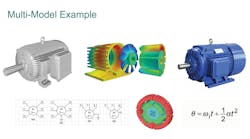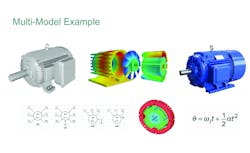At a Glance:
- A digital twin is a multifaceted digital model of a physical instance.
- The primary function of the digital twin is to provide an accurate representation of a manufactured product, although it could just as well apply to a process or service.
- A digital thread is a set of connected records capturing the data and activities that define a product, or in some cases, a process.
- Many types of twins and models exist in today’s manufacturing landscape, most of which serve specific purposes.
Digital twins continue to have a huge impact on design and manufacturing organizations. According to Gartner, two-thirds of companies are planning on using the technology to support their Internet of Things (IoT) initiatives. And market intelligence firm IDC recently predicted that 70% of manufacturers will soon be using Digital twins to conduct simulations and scenario evaluations, reducing equipment failures by 30%.
Tying onto the Digital Thread
Before we talk more about digital twins, we need to understand the Industry 4.0 concept that supports them: the digital thread. Systems integrator and consulting firm Razorleaf describes the digital thread as a set of connected records capturing the data and activities that define a product, or in some cases, a process. The first of these—the data—refers to the requirements, models, drawings, specifications, bills of material (BOMs), analyses and product manufacturing information (PMI) used to produce a manufactured good.
The activities defining a product are less obvious, but might include tasks that were performed as part of the project plan, and what suppliers or subcontractors were used during the manufacturing process. They might also include the engineering release and change processes as well as the design review meetings performed during product development. The digital thread connects all this information together, giving its users access to a complete definition of a product or process as well as the context in which it was developed.
Constructing a digital thread usually begins by defining what the product or service needs to do and why it’s necessary. From there it’s a matter of taking these requirements and imagining how you might address them, breaking each down into the functions or features or logical components that the product must offer. This activity is quite important, as is the act of capturing all the different information that will be generated during the process.
After that, there’s the organization of product-related content, as well as change-management processes, BOM and 3D model definition, design analysis and optimization, configuration management and the manufacturing process itself. Each of these brings with it a host of related activities, information and data, all of which will be attached somewhere along the digital thread. The result is a comprehensive, cradle-to-grave view of the product or process.
Twins are Twice as Nice
So what is a digital twin, and how does it fit with the digital thread? Great question. Answering it requires another definition, however. At Razorleaf, a digital twin is a multifaceted digital model of a physical instance. An instance is the unique result created from a digital product definition or resulting from a digital process recipe. Assuming your manufacturing facility requires four hours to make your product, you’ll create 10 physical instances in a 40-hour week. Serial number 33621 made on July 15 is one physical instance of your product. As you would imagine, SN 33621 will be very similar to (but slightly different from) SN 79128 made two years later. If you could compare the digital twin of SN 33621 to the digital twin of SN 79128, you could tell exactly what was different between them—and you would certainly be referencing the digital thread for this product to do that comparison.
The primary function of the digital twin is to provide an accurate representation of a manufactured product, although it could just as well apply to a process or service. Note the singular use of the word “product.” This is a key point, because a company that manufactures and monitors 1,000 of something will also have 1,000 digital twins to represent them, each one unique and carrying its own set of instance-specific data and information.
Simply put, a digital twin is much more than a 3D CAD model. It’s more than a product’s electrical schematics, or thermal simulation analyses, or the realistic rendering that the marketing team uses to promote it. A digital twin brings some or even all of these different facets together into a single virtual space that uniquely represents a physical instance. It allows us to better understand and hopefully predict that object’s behavior, and provides the information needed to continuously improve its performance.
What’s in a Name?
Any discussion of digital twins is tricky because A) there are a lot of similar terms out there, and B) a lot of people are using them. There are also product twins, process twins, factory twins and so on, each with its own capabilities, granular data and benefits. These provide an accurate representation of the product—or process—at a certain point in time, along with clear definitions of how that digital information will be shared.
That said, there’s one twin that warrants further explanation: the virtual twin. Because the digital twin is tied to a specific physical object, it cannot actually exist until that object leaves the manufacturing line. The virtual twin, on the other hand, typically appears long before the physical product. It describes the design of the product, the process used to make it, the testing specifications and so on. In many cases, it can be thought of as a prototype—one that requires no tooling or machining, thus saving its maker significant time and money.
Details, Details
Just as manufacturing companies differ from one another, so do their digital twin definitions. For example, the details needed for aircraft production are a world apart from those of lightbulb manufacturing. For one, there’s product longevity to consider. An aircraft can easily be in service for several decades, whereas the lightbulb in your hallway might last but a year. In each case, their manufacturers will put a commensurate amount of effort into defining and then maintaining those products’ digital twins.
Data privacy plays a crucial role here as well. No one who flies would argue over gathering every bit of aircraft data possible. The GPS in the family car might be a different matter entirely. Couple these concerns with the cost of product-mounted sensors to gather usage information and an internet connection to transmit it back to the digital twin, and it’s clear that IoT-capable products don’t always make sense.
Better Decisions
Challenges aside, the benefits of digital twins supported by a robust digital thread are many. The first of these is improved decision-making capabilities due to the wealth of product and usage-specific information contained within the digital twin. A solar panel maintenance technician, for instance, would see that the panel she’s working on has been repaired three times already and will likely not survive another attempt. This might seem like a trivial example until you think about the countless number of similar decisions made each day by manufacturers and maintenance people everywhere.
Further, that technician could have run a what-if analysis to determine whether her assessment was accurate. She would know what levels of solar radiation the panel had absorbed since its installation date, its maximum temperature and what effect taking the panel offline will have on the grid.
Equally important are any future decision-making capabilities. Because the solar technician’s actions on that day become a permanent part of that panel’s digital twin, manufacturers can use this data to spot trends and identify improvement opportunities for future product iterations. They’re able to perform root cause analyses to determine whether the bad panel was an aberration or whether a recall is in order, and how it will impact the company. For these and countless other reasons, the benefits of a digital twin strategy are significant.
The Digital Building Blocks
So what’s required to develop such a strategy? Ideally, a digital twin builds from a solid digital thread, and for that you need the data sources—the models and specifications and requirements—described earlier. Here again, each company and product is different, but this generally means access to robust, well-implemented design, simulation, product lifecycle, and configuration management tools and software platforms.
It also requires a virtual twin, as this provides an “as-intended” reference version of the product, establishing a performance baseline against which the future digital twin and its physical counterpart can be measured. Of course, this assumes that some manner of unit/instance tracking exists for products in the field, that such products have the appropriate sensors or other data collection devices installed, and that there’s the means to collect relevant usage and performance data. Without this last critical piece, the digital twin will not produce the desired results.
It might sound like a lot of work, but when you consider the benefits, it’s easy to see why manufacturers everywhere are pursuing a digital strategy, the culmination of which is the digital twin. Supported by the digital thread and the IoT, it serves as the basis for future competitiveness and corporate growth, traceability and continuous improvement, greater product safety, performance and customer satisfaction. Maybe it’s time to ensure that your company has a solid digital thread that facilitates these business goals.
Derek Neiding is engagement director and Jonathan Scott is chief architect at Razorleaf.

